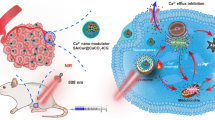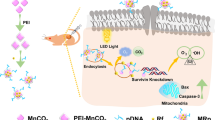Abstract
Photodynamic therapy (PDT), which is a procedure that uses photosensitizing drug to apply therapy selectively to target sites, has been proven to be a safe treatment for cancers and conditions that may develop into cancers. Nano-sized TiO2 has been regarded as potential photosensitizer for UV light driven PDT. In this study, four types of TiO2 nanofibers were prepared from proton tri-titanate (H2T3O7) nanofiber. The as-obtained nanofibers were demonstrated as efficient photosensitizers for PDT killing of HeLa cells. MTT assay and flow cytometry (FCM) were carried out to evaluate the biocompatibility, percentage of apoptotic cells, and cell viability. The non-cytotoxicity of the as-prepared TiO2 nanofibers in the absence of UV irradiation has also been demonstrated. Under UV light irradiation, the TiO2 nanofibers, particularly the mixed phase nanofibers, displayed much higher cell-killing efficiency than Pirarubicin (THP), which is a common drug to induce the apoptosis of HeLa cells. We ascribe the high cellkilling efficiency of the mixed phase nanofibers to the bandgap edge match and stable interface between TiO2(B) and anatase phases in a single nanofiber, which can inhibit the recombination of the photogenerated electrons and holes. This promotes the charge separation and transfer processes and can produce more reactive oxygen species (ROS) that are responsible for the killing of HeLa cells.

Similar content being viewed by others
References
Fujishima, A.; Hashimoto, K.; Watanabe, H. TiO 2 Photocatalysis: Fundamentals and Applications; BKC, Inc.: Tokyo, 1999.
Hoffman, M. R.; Martin, S. T.; Choi, W.; Bahnemann, D. W. Environmental application of semiconductor photoctalysis. Chem. Rev. 1995, 95, 69–96.
Linsebigler, A. L.; Lu, G. Q.; Yates, J. T. Photocatalysis on TiO2 surfaces: Principles, mechanisms, and selected results. Chem. Rev. 1995, 95, 735–758.
Rozhkova, E. A.; Ulasov, I.; Lai, B.; Dimitrijevic, N. M.; Lesniak, M. S.; Rajh, T. A high-performance nanobio photocatalyst for targeted brain cancer therapy. Nano Lett. 2009, 9, 3337–3342.
Songa, M.; Zhanga, R.; Daib, Y.; Gaob, F.; Chia, H.; Lva, G.; Chenb, B.; Wang, X. The in vitro inhibition of multidrug resistance by combined nanoparticulate titanium dioxide and UV irradiation. Biomaterials 2006, 27, 4230–4238.
Seo, J. W.; Chung, H.; Kim, M. Y.; Lee, J.; Choi, I. H.; Cheon, J. Development of water-soluble single-crystalline TiO2 nanoparticles for photocatalytic cancer-cell treatment. Small 2007, 3, 850–853.
Higuchi, Y. Chromosomal DNA fragmentation in apoptosis and necrosis induced by oxidative stress. Biochem. Pharmacol. 2003, 66, 1527–1535.
Huang, P.; Pandoli, O.; Wang, X.; Wang, Z.; Li, Z.; Zhang, C.; Chen, F.; Lin, J.; Cui, D.; Chen, X. Chiral guanosine 5′-monophosphate-capped gold nanoflowers: Controllable synthesis, characterization, surface-enhanced Raman scattering activity, cellular imaging and photothermal therapy. Nano Res. 2012, 5, 630–639.
Terentyuk, G.; Panfilova, E.; Khanadeev, V.; Chumakov, D.; Genina, E.; Bashkatov, A.; Tuchin, V.; Bucharskaya, A.; Maslyakova, G.; Khlebtsov, N. et al. Gold nanorods with a hematoporphyrin-loaded silica shell for dual-modality photodynamic and photothermal treatment of tumors in vivo. Nano Res. 2014, 7, 325–337.
Brooker, R. J. Genetics: Analysis and Principles (4th Ed.). McGraw-Hill Science: 2011.
Townley, H. E.; Kim, J.; Dobson, P. J. In vivo demonstration of enhanced radiotherapy using rare earth doped titania nanoparticles. Nanoscale 2012, 4, 5043–5050.
Ackroyd, R.; Brown, K. C.; Reed, M. The history of photodetection and photodynamic therapy. Photochem. Photobiol. 2001, 74, 656–669.
Yang, D.; Liu, H.; Zheng, Z.; Yuan, Y.; Zhao, J. C.; Waclawik, E. R.; Ke, X.; Zhu, H. An efficient photocatalyst structure: TiO2(B) nanofibers with a shell of anatase nanocrystals. J. Am. Chem. Soc. 2009, 131, 17885–17893.
Zheng, Z.; Liu, H.; Ye, J.; Zhao, J.; Waclawik, E. R.; Zhu, H. Structure and contribution to photocatalytic activity of the interfaces in nanofibers with mixed anatase and TiO2(B) phases, J. Mol. Catal. A: Chem. 2010, 316, 75–82.
Yang, D.; Zhao, J.; Liu, H.; Moses, A.; Liu, X.; Zhang, H.; Zheng, Z.; Bell, J.; Zhao, J.; Zhu, H. Enhancing photoactivity of TiO2(B)/anatase core-shell nanofibers by selectively doping cerium ions into the TiO2(B) core. Chem. Eur. J. 2013, 19, 5113–5119.
Hayashi, K.; Nakamura, M.; Sakamoto, W.; Yogo, T.; Kori, T.; Ishimura, K. Formation of TiO2 nanostructures by enzyme-mediated self-assembly for the destruction of macrophages. Chem. Mater. 2011, 23, 3341–3347
Zheng, Z.; Huang, B.; Qin, X.; Zhang, X.; Dai, Y. Synthesis of hierarchical TiO2 microspheres with enhanced photocatalytic activity. Chem. Eur. J. 2010, 16, 11266–11270.
Xu, J.; Sun, Y.; Huang, J.; Chen, C.; Liu, G.; Jiang, Y.; Zhao, Y.; Jiang, Z. Photokilling cancer cells using highly cell-specific antibody-TiO2 bioconjugates and electroporation. Bioelectrochem. 2007, 71, 217–222.
Feng, X.; Zhang, S.; Lou, X. Controlling silica coating thickness on TiO2 nanoparticles for effective photodynamic therapy. Colloid. Surf. B: Biointerf. 2013, 107, 220–226.
Zhu, H. Y.; Gao, X. P.; Lan, Y.; Song, D. Y.; Xi, Y. X.; Zhao, J. C. Hydrogen titanate nanofibers covered with anatase nanocrystals: A delicate structure achieved by the wet chemistry reaction of the titanate nanofibers. J. Am. Chem. Soc. 2004, 126, 8380–8381.
Lan, Y.; Gao, X. P.; Zhu, H. Y.; Zheng, Z. F.; Yan, T. Y.; Wu, F.; Ringer, S. P.; Song, D. Y. Titanate nanotubes and nanorods prepared from rutile powder. Adv. Funct. Mater. 2005, 15, 1310–1318.
Zhu, H. Y.; Lan, Y.; Gao, X. P.; Ringer, S. P.; Zheng, Z. F.; Song, D. Y.; Zhao, J. C. Phase transition between nanostructures of titanate and titanium dioxides via simple wet-chemical reactions J. Am. Chem. Soc. 2005, 127, 6730–6736.
Li, Q.; Wang, X.; Lu, X.; Tian, H.; Jiang, H.; Lv, G.; Guo, D.; Wu, C.; Chen, B. The incorporation of daunorubicin in cancer cells through the use of titanium dioxide whiskers. Biomaterials 2009, 30, 4708–4715.
Li, J.; Wang, X.; Jiang, H.; Lu, X.; Zhu, Y.; Chen, B. New strategy of photodynamic treatment of TiO2 nanofibers combined with celastrol for HepG2 proliferation in vitro, Nanoscale 2011, 3, 3115–3122.
Yang, D.; Zheng, Z.; Zhu, H.; Liu, H.; Gao, X. Titanate nanofibers as intelligent absorbents for the removal of radioactive ions from water. Adv. Mater. 2008, 20, 2777–2781.
Yang, D.; Sarina, S.; Zhu, H.; Liu, H.; Zheng, Z.; Xie, M.; Smith, S. V.; Komarneni, S. Capture of radioactive cesium and iodide ions from water by using titanate nanofibers and nanotubes. Angew. Chem. Int. Ed. 2011, 50, 10594–10598.
Yang, D.; Zheng, Z.; Yuan, Y.; Zhu, H.; Liu, H.; Waclawik, E. R.; Ke, X.; Xie, M. Sorption induced structural deformation of sodium hexa-titanate nanofibers and their ability to selectively trap radioactive Ra(II) ions from water. Phys. Chem. Chem. Phys. 2010, 12, 1271–1277.
Liu, H.; Waclawik, E.; Zheng, Z.; Yang, D.; Ke, X.; Zhu, H.; Frost. R. TEM Investigation and FBB model explanation to the phase relationships between titanates and titanium dioxides. J. Phys. Chem. C. 2010, 114, 11430–11434.
Oleinick, N. L.; Morris, R. L.; Belichenko, I. The role of apoptosis in response to photodynamic therapy: What, where, why, and how. Photochem. Photobiol. Sci. 2002, 1, 1–21.
Oleinick, N. L. Apoptosis in response to photodynamic therapy. Photodynamics News 1998, 6, 8–9.
Koffyberg, F. P.; Dwight, K.; Wold, A. Interband transitions of semiconducting oxides determined from photoelectrolysis spectra. Solid State Commun. 1979, 30, 433–437.
Kim, Y. I.; Atherton, S. J.; Brigham, E. S.; Mallouk, T. E. Direct splitting of water under visible light irradiation with an oxide semiconductor photocatalyst. J. Phys. Chem. B 1993, 97, 11802–11810.
Enright, B.; Fitzmaurice, D. Spectroscopic determination of electron and hole effective masses in a nanocrystalline semiconductor film. J. Phys. Chem. 1996, 100, 1027–1035.
Author information
Authors and Affiliations
Corresponding authors
Rights and permissions
About this article
Cite this article
Zhang, S., Yang, D., Jing, D. et al. Enhanced photodynamic therapy of mixed phase TiO2(B)/anatase nanofibers for killing of HeLa cells. Nano Res. 7, 1659–1669 (2014). https://doi.org/10.1007/s12274-014-0526-8
Received:
Revised:
Accepted:
Published:
Issue Date:
DOI: https://doi.org/10.1007/s12274-014-0526-8




